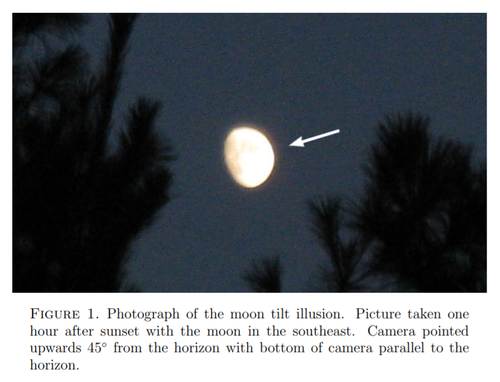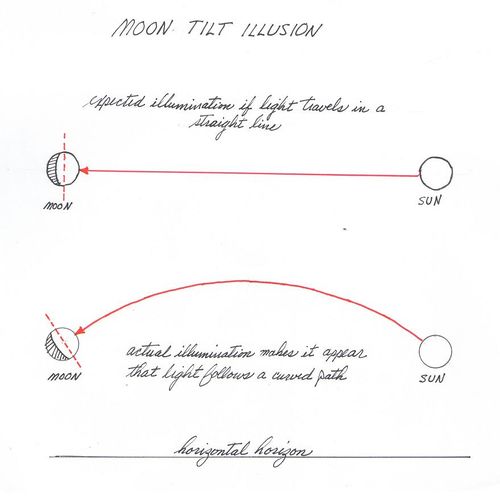Moon Tilt Illusion
Description
Professor Myers at the University of Pennsylvania provides the following description:
http://www.upenn.edu/emeritus/essays/MyersMoon.html (Archive)
“ One evening several years ago, I took this picture of the misty glow of an almost full moon shining between pine trees in my backyard. The moon was beautifully illuminated and dominated the dark sky. Yet something was disturbing about the atmospheric night scene: the illumination of the moon seemed to be coming from the wrong direction! In this photograph of a waxing moon in the southern sky, its illumination appears to be coming from above to the right. But the sun---which had set an hour earlier---was already below the western horizon to the right when this photo was taken. If the sun is below the horizon, I thought, shouldn't its illumination of the moon appear to be coming from below the horizon? Intrigued, I made further observations when both the sun and the moon occupied the evening sky at the same time, and it certainly seemed that light rays from the sun would have to follow a curved path to shine on the moon at the observed angle. The sketch drawn below may help to explain the difference between what I expected to see and what I actually saw.
I asked everyone willing to listen if they were familiar with this illusion: why does a light ray from the sun to the moon appear to follow a curved path? No one had seen or heard of it. Several imaginative explanations were offered: "The light rays are bent by the earth's atmosphere." Or, "Gravitational lensing as predicted by Einstein's general theory of relativity is responsible." I was surprised not to find the illusion described in astronomy textbooks. I googled "moon illusion" but the articles were about an entirely different illusion: the apparent magnification of the full moon when it's close to the horizon.
Finally, help came from my daughter, who located published papers by googling "moon tilt illusion". The scientific explanation is based on the projection of a straight line onto the surface of a sphere. A simpler explanation was provided in a conversation with Benjamin Shen, Professor Emeritus of Astronomy at Penn, who said that light appears to follow a great circle route from the sun to the moon. That's why the moon's lit face appears to us not to face the sun squarely, regardless of whether the sun is above or below the horizon.
The moon tilt illusion is counter-intuitive and magical---look for it the next time you are under a night sky. ”


